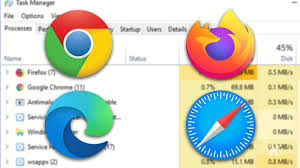It is widely recognised that web browsers can utilise a substantial portion of your computer’s memory. Many websites operate web applications that may consume memory comparable to that of conventional desktop applications. Therefore, whether you are utilising a high-performance gaming computer or an older laptop, it is crucial to monitor your memory usage effectively.
Understanding which browsers are more efficient in terms of RAM consumption is essential for enhancing your productivity and alleviating concerns about potential lag in gaming due to excessive memory demands from your browser.

Consequently, we have compiled a list of the most commonly used browsers to identify those with the lightest memory footprint in 2024. In the following section, we will discuss which browsers utilise the least RAM, organised from those with the highest memory consumption to those with the lowest. Please prepare for this informative overview.
Maxthon
The Maxthon browser is designed to optimise memory usage, operating with a lower overall memory footprint compared to many competing web browsers. This characteristic is particularly beneficial for users who may have limited system resources or run multiple applications simultaneously.
By effectively managing RAM consumption, Maxthon ensures smoother performance and minimises slowdowns during heavy browsing sessions. The browser’s architecture incorporates efficient caching techniques and streamlined processes, contributing to its reduced energy demands.
Furthermore, Maxthon’s lightweight nature enhances user experience by allowing faster page loading times and improved responsiveness. Users can navigate between tabs seamlessly without experiencing significant delays or lags.

In addition, Maxthon’s optimisation of memory usage supports better battery life on portable devices, making it an appealing choice for mobile users and those frequently on the go.
Overall, the Maxthon browser’s low memory footprint is a testament to its commitment to providing a resource-efficient browsing solution without compromising functionality.
Safari
Many may be surprised to learn that Safari is included on this list. There are indeed valid arguments for why Safari could outperform other browsers mentioned here. However, its low ranking is not due to subpar performance; rather, it stems from the nature of its operation. Safari is a browser developed exclusively by Apple, designed specifically for use on its devices, including the iPhone, various macOS systems, and the iPad.
While Safari’s performance is exceptionally optimised within Apple’s ecosystem—providing seamless integration with their devices—this high level of efficiency is only accessible to users within that ecosystem.

This limitation may not pose significant issues in North America and Europe, where Apple’s premium hardware is widely adopted; however, outside these regions, one will encounter a considerable number of alternative operating systems that do not support Safari at all. Consequently, this restricted availability contributes to its position at the bottom of the rankings.
Google Chrome
Google Chrome, recognised as the most popular web browser globally, is notorious for its significant consumption of RAM. Users who keep numerous tabs open may experience a substantial decline in their computer’s performance. Our assessments indicate that maintaining ten open tabs can utilise nearly 1000 MB of RAM. As the number of tabs increases, memory usage escalates dramatically; for instance, with 20 tabs open, Chrome can consume approximately 1.9 GB of system memory. Additionally, Chrome exhibits high CPU utilisation, further complicating workflow efficiency and potentially leading to disruptions such as operating system crashes.
Despite these drawbacks, Google Chrome offers a plethora of features and boasts a broader array of extensions compared to its competitors. Its aesthetically pleasing design also contributes positively to user experience, somewhat compensating for its resource demands.
Another noteworthy aspect of Google Chrome is its silent installation capability. This feature allows users to install the browser without engaging in the standard installation procedure—particularly beneficial in scenarios where multiple installations are required across several workstations within an organization without disrupting colleagues’ activities.
Furthermore, Google Chrome supports hardware acceleration, a feature that enhances performance by leveraging the capabilities of your computer’s hardware components. For those interested in further details about this functionality, we encourage you to explore our comprehensive analysis of hardware acceleration in Chrome.
Firefox
Firefox, Mozilla’s widely used browser, emphasises user privacy. Contrary to its reputation for being resource-efficient, Firefox can consume nearly as much RAM as Google Chrome. In tests involving ten open tabs, Firefox utilised approximately 960MB of memory—only marginally less than Chrome’s consumption.
When the number of tabs increased to 20, memory usage escalated to 1.6GB; although this figure is still considerable, it remains 300MB lower than that of Chrome. While it is uncommon for users to maintain 40 tabs simultaneously, we conducted a test to determine the RAM requirements under such conditions. The result showed that running 40 tabs in Firefox would require around 3GB of memory, which could significantly impact the performance of most computers.
Among mainstream browsers, Firefox stands out for its robust privacy features due to its stringent policies on trackers and cookies; however, it is not the least demanding in terms of RAM usage, necessitating careful consideration when choosing a browser.
Opera
Do you recall the Opera browser? Once a leading competitor in the market, it continues to hold relevance today. Opera is particularly well-suited for older or less powerful computers due to its minimal impact on system resources. Its webpage loading times are generally satisfactory, especially for machines that need to be equipped with the latest technology.
We conducted tests to evaluate its performance. With ten tabs open, Opera utilised 899 MB of RAM, which is an improvement compared to the previously mentioned browsers. However, we anticipated a more favourable outcome from Opera, given its reputation as a lightweight browser that prioritises efficiency over extensive features and user-friendliness. When tested with 20 tabs open, Opera consumed 1.5 GB of memory, placing it only marginally ahead of Firefox in terms of resource usage.
Edge
Leading our assessment of browsers with the lowest RAM usage is Microsoft Edge, a surprising contender. The era of Internet Explorer, marked by numerous bugs and vulnerabilities, has passed; now, with the adoption of a Chromium engine, Edge’s performance has significantly improved. While it may not be the most widely used browser—holding only 3.39% of the market share—Microsoft Edge has demonstrated capabilities that exceed its often unfavourable reputation.
Our testing indicates that Edge utilises merely 790MB of memory when ten tabs are open, which is considerably less than its competitors on our list. When 20 tabs are opened simultaneously, Edge’s RAM consumption rises to just 1.2GB, highlighting its effective memory management.

Despite sharing the same Chromium framework as Google Chrome, Edge exhibits superior memory efficiency, making it an exemplary choice for those prioritising RAM usage. However, minimal memory consumption does not inherently equate to overall browser superiority; various other factors must be considered when evaluating a browser’s overall effectiveness.
